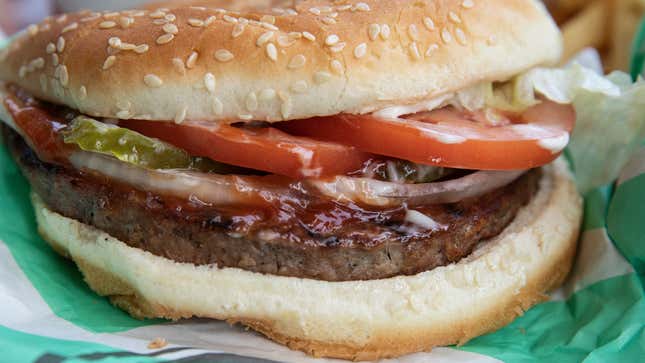Pour One Out for the Whopper Sacrificed to Make This Viral Ad
Latest

For reasons that defy logic, Burger King has cursed us all with the image of a moldy rotting Whopper to advertise the company’s new commitment to using preservative-free ingredients in their food. In an attempt to lure millennials back into the bosom of the royal fast-food chain, Restaurant Brands International, owners of Burger King, want to implement “real food”–meaning food that is physically capable of rot— into BK chains worldwide. Seems like a formula for success: If there’s one thing Millenials are reported to love, it’s the term organic in front of just about anything.
The ad starts off with an expertly styled Whopper against an all-black backdrop; over a 34-day time-lapse, the Whopper starts to wilt and molduntil it morphs into a furry burger of nightmares. This pile of rot is intended to illustrate the “beauty of real food.” While the method of sharing this information is, to put it nicely, fucking gross, the thinly veiled attempt at health washing a cheeseburger is even grosser than a molding bread bun. Cheeseburgers, at their core, are a cheap way to eat a sizeable meal on the go. No matter how hard restaurants try to elevate the humble burger or strip it of additives and preservatives, it is still a hunk of meat with some toppings that loosely resemble vegetables, cheese, and ketchup. Why does it need to be something different?
Healthy food has its place, but when it’s Saturday night and the third hour of that binge marathon hits, not that many people are reaching for a quinoa bowl. But still, Burger King is trying to shift the perception of its food, if not the actual product: First was the Impossible Whopper tailored to fast food-loving vegetarians and meat substitute skeptics. It was all fine and dandy until diners realized that an Impossible Whopper has over 200 more milligrams of sodium than a meat Whopper.
This perception shift requires that the company’s audience not know much about food. Though the ad didn’t specify what preservatives were being removed, a spokesperson for Burger King told the Washington Post about the replacements: “Sodium benzoate would be removed from the pickles and replaced with lactic acid; ethylenediaminetetraacetic acid (EDTA) would be removed from the mayonnaise; and calcium propionate would be removed from the buns and replaced with cultured wheat flour.” This kind of information doesn’t help the average consumer, who doesn’t know the difference between sodium benzoate and lactic acid without an extensive Google search or a degree in nutrition. The truth is, there isn’t much of a difference. (As scientist Lisa Lefferts told the Washington Post, the company is essentially using a naturally-derived version of the same preservative.)
While this new version of the Whopper might be more“real” it’s just a buzz word for something that will continue to be what it’s always been: a delicious grilled grease ball in between some toasted carb balls. While the moldy ad is, at its heart, a misleading move, it succeeded on two levels. The unfiltered rotting Whopper pic has gone viral and reminded people that no matter the ingredients, BK makes a better burger than McDonald’s (fight me). And, the photo has stabbed in the face any meat cravings I’ve had since going vegetarian a few months ago. After upsetting the vegans with their mishandling of the Impossible Whopper roll out I’m anxious to see how long it takes the zero waste movement to pounce on this ad for promoting unnecessary food waste. A moment of silence for the preservative-free ingredients that were sacrificed to make this ad campaign happen.